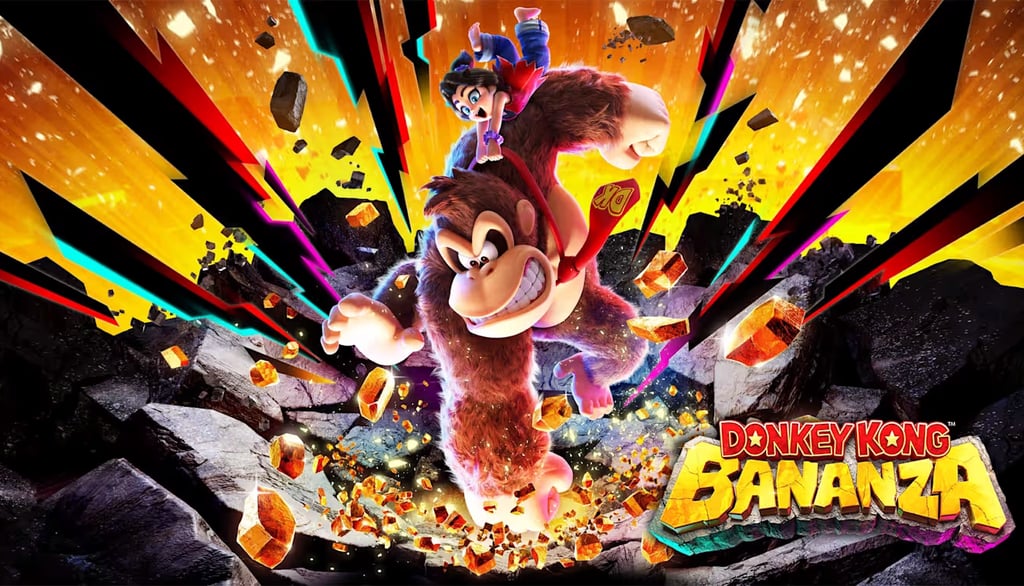Donkey Kong Bananza – DK is Back!
Donkey Kong Bananza brings back Nintendo’s most famous gorilla in a brand-new 3D platforming adventure packed with action. In this installment, almost the entire environment can be destroyed with DK’s brute strength, adding a fresh and addictive mechanic. Join Donkey Kong and a young Pauline on a colorful underground journey filled with nostalgic secrets and challenges, where breaking the stage is the key to progressing and uncovering all its surprises.
REVIEWS
Carles "Zettai"
8/15/20256 min read


Introduction
It’s been over ten years since Donkey Kong’s last main adventure, and Bananza finally arrives to fill that gap. Developed by Nintendo for the new Switch 2, this title seeks to refresh the classic platforming formula with a radical idea: letting us tear down the environment itself. The result is a game that blends the familiar—jumping, exploration, and Nintendo-style collectibles—with the novelty of its destruction system. The narrative premise, unusually emotional for the series, places Donkey Kong in the role of protector of Pauline, the original arcade damsel now reimagined as a child, as they descend into the earth to find a magical core said to grant wishes and return her home. This journey to the center of the world serves as the backdrop for a humorous and heartwarming adventure, as well as a technical showcase of what Nintendo’s new console can deliver. But does it live up to the legacy of the legendary ape? Let’s take a closer look.
Story and Characters
Traditionally, Donkey Kong games haven’t been known for their stories, but Bananza surprises with a simple yet effective narrative. DK embarks on the adventure after meeting Pauline, and along the way we see a growing bond between the rough gorilla and the clever young girl. Pauline adds a refreshing dynamic to the series: far from being a burden, she’s a charismatic and useful companion, offering advice and reactions that add warmth to the journey. Her voiced dialogues (a rarity in Mario/DK titles) give her plenty of personality, turning every break into an opportunity to get to know her better. The tone is lighthearted and adventurous with classic Nintendo humor, yet also features surprisingly tender and emotional moments. Without spoiling too much, some late-game scenes are touching, reminding us that even in a wild platformer, genuine heart can shine through.
Don’t expect a complex plot or elaborate twists—it’s still designed for all ages with a straightforward conflict. The final villain or challenge plays its role without much flair, but the real focus is the journey and the chemistry between the protagonists. In this sense, Bananza works as a tribute to Donkey Kong’s history: there are numerous nods to past games woven into the adventure, from visual references to playful jokes for veteran fans. Pauline herself is a living callback to DK’s origins, and her presence keeps things fresh. Overall, the story succeeds: it’s fun, faithful to the franchise’s spirit, and provides a pleasant thread to motivate progression.
Gameplay and Mechanics
The core of Donkey Kong Bananza shines through its innovative destruction mechanic. While it’s a 3D platformer, each level becomes a destructible playground where nearly any wall, floor, or structure can be smashed with DK’s brute strength. True to his legendary power, DK can crush rocks, topple walls, dig tunnels, and generally wreak havoc. This is entertaining on its own, but also adds meaningful gameplay depth. On one hand, it creates satisfying, almost cathartic chaos: few things are as fun as smashing everything in sight. On the other, destruction is practical—progress often requires breaking through seemingly solid barriers. Exploration by brute force is rewarded, with collectibles hidden behind cracked walls or under fragile ground.
DK’s controls feel surprisingly polished given the complexity of so much interaction. Precise jumping still matters, but now pairs with punching and object-throwing. DK’s weight and power are conveyed beautifully—you really feel like a massive gorilla shaking the world. Beyond basic punches, Bananza introduces special abilities and animal transformations inspired by old allies (yes, DK can even become a zebra!), each allowing him to overcome specific obstacles. These transformations keep gameplay varied and are key to boss fights, while also serving puzzle-solving purposes.
Progression ties neatly into gameplay. Collecting golden bananas—the equivalent of Mario Odyssey’s moons or Mario 64’s stars—unlocks skill points to upgrade DK’s health, strength, and transformations. Fossils scattered across the map act as currency for costumes and accessories for DK and Pauline. These aren’t just cosmetic—outfits provide gameplay benefits like faster swimming or higher treasure find rates. This personalization layer motivates exploration, making every smashed wall or hidden nook worthwhile.
Combat, meanwhile, is simple. DK’s punches, grabs, and stomps take down basic enemies easily, and world bosses are straightforward once you figure out their mechanics (often involving transformations or environmental tricks). Veteran players may find the fights lacking in challenge, though they remain visually impressive and thematically fitting. To balance the constant smashing, puzzle shrines—reminiscent of Zelda’s shrines—offer lighter brain-teasing diversions. This alternation between chaotic destruction and thoughtful puzzles keeps the adventure fresh.
Level Design and Exploration
DK and Pauline’s odyssey takes them through a massive underground world divided into multiple “layers” of depth. Each cleared zone pushes you further into the earth, revealing new and surprising biomes. This descent structure creates a strong sense of cohesion, making the adventure feel like a genuine “journey to the center of the Earth.” Surprisingly, despite the subterranean setting, the environments remain varied: glowing crystal caverns, bioluminescent forests, ancient ruins, and even a hidden underground beach. Each world has its own visual and musical theme, maintaining a constant sense of discovery.
Levels favor open exploration over linear paths, leaning closer to Mario Odyssey-style sandboxes than strict platforming corridors. The destruction mechanic enhances this freedom, letting players uncover shortcuts, create new paths, and find hidden entrances by smashing suspicious spots. Secrets and collectibles are plentiful, rewarding experimentation.
Completing the main story takes dozens of hours with exploration, and post-game content adds tougher challenges that push mastery of DK’s abilities. Optional NPC quests at camps between levels offer light side objectives like collecting items or helping characters, adding some variety. While not all environments are memorable—some mid-game caves feel generic or visually repetitive—the variety of mechanics keeps things engaging. Easter eggs abound, with nods to Donkey Kong Country, DK64, and Rare’s influence, making exploration rewarding for fans as both gameplay and nostalgia.
Art Direction and Technical Performance
Visually, Bananza is spectacular. The Switch 2’s power enables expansive environments, vibrant lighting, and particle effects, particularly during destruction sequences. Watching walls crumble and debris scatter feels chaotic and satisfying. The underground palette balances vibrancy with darkness, avoiding monotony. DK and Pauline are well-modeled and expressive, bringing humor and warmth to the adventure.
The art style blends Nintendo’s cartoon charm with fantastical underground themes. Deeper layers grow increasingly surreal, pushing creativity while maintaining coherence. Technically, performance is mostly stable despite the heavy physics, though occasional frame drops occur during extreme chaos. Docked mode sees slightly more slowdowns than handheld. The camera, while mostly functional, struggles in tight tunnels—rare but noticeable. Overall, though, Bananza is polished and a technical showcase for Switch 2.
Sound Design
The soundtrack is bursting with tropical energy and adventurous spirit, mixing percussion-heavy rhythms, jazz touches, and orchestral swells for epic moments. As you descend, the music adapts, shifting to mysterious or atmospheric tones fitting each biome. Fans will catch musical nods to Donkey Kong Country, and even playful riffs of the DK Rap. Sound effects enhance the joy of smashing, with distinct audio feedback for wood, stone, and metal destruction, alongside DK’s iconic grunts. Pauline’s voice acting adds charm, though only key dialogues are voiced. Spanish text localization is included, though voices remain in English with subtitles.
The Good
Innovative, satisfying, and addictive environment destruction mechanic.
Colorful, varied environments with secrets encouraging constant exploration.
Well-integrated collectibles and upgrade systems.
Pauline and other characters bring charm and freshness.
A heartfelt homage to Donkey Kong’s history, full of nostalgic nods.
The Bad
Action can grow repetitive over long sessions.
Accessible difficulty; combat and bosses may feel too easy for veterans.
Camera issues in tight spaces.
Occasional performance drops during heavy chaos.
Conclusion
Donkey Kong Bananza is the triumphant return DK fans have been waiting for. Nintendo delivers a platformer that feels fresh and unique, thanks to the bold focus on destruction. Smashing through environments is just as fun as it sounds, while the adventure exudes the carefree joy characteristic of Nintendo at its best. At the same time, it respects the series’ history, brimming with nostalgic details and love for DK’s legacy.
Though not perfect—too easy for some, and occasionally repetitive—it succeeds as a creative, joyful, and technically impressive showcase for Switch 2. It’s a festival of fun and creativity, proving that Donkey Kong still has what it takes to be a genre leader.
Final Score: 9.5/10
Recommended for:
Donkey Kong and 3D platforming fans (Mario, Banjo, etc.).
Players who love exploring open levels for secrets and collectibles.
Those seeking an accessible, original, and immensely fun action-platformer.
Gamers who enjoy creative mechanics that encourage freedom and experimentation.
Available on: Nintendo Switch 2 and Nintendo Switch (via GameShare with Switch 2).
© 2025. All rights reserved.
And remember, if you’re into games... you’re into Sector Gaming!
